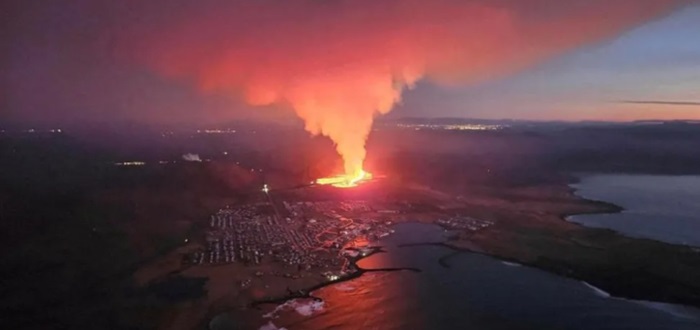Houses have been set on fire in the Icelandic town of Grindavik after two volcanic fissures opened nearby.
A volcano on the Reykjanes peninsula erupted in the early hours of Sunday, spilling lava into the fishing town.
The eruption is proving to be “the worst case scenario” according to one expert, with the entire population of the town being evacuated.
Defences built after an eruption in December have partially contained the lava, but some have been breached.
The main road into the town has been cut off by the flow of lava.
Addressing the nation in a live broadcast on Sunday evening, Iceland’s President Gudni Johannesson urged people to “stand together and have compassion for those who cannot be in their homes”.
He said he hoped the situation would calm down, but that “anything can happen”, the AFP news agency reported.
Strong earthquake tremors preceded the December eruption in the Svartsengi volcanic system. In the weeks since, walls were built around the volcano to direct molten rock away from Grindavik, home to some 4,000 people.
The Icelandic Meteorological Office (IMO) said the barriers had been breached in some places, allowing lava to reach the town which then set houses and buildings on fire.
There was no indication of disruption to domestic or international flights following the eruption. The IMO’s aviation colour code for the Reykjanes peninsula was orange on Monday morning, indicating an ongoing eruption with “no or minor ash emission”.
Flights from nearby Keflavik Airport were operating as normal.
People who had returned to Grindavik, in south-west Iceland, after the previous eruption were forced to leave their homes once again.
Science journalist and volcanologist Robin Andrews said the ongoing eruption is an “extremely perilous and deleterious situation” now that lava has made its way into the town.
Speaking to the BBC, he pointed out that the outpour of lava from the two current fissures shows “no sign of slowing down”.
“In terms of duration and severity of damage its impossible to map at this moment,” he said.
He warned that the aftermath of the eruption could prove “fairly problematic” for people with pre-existing respiratory problems, because volcanic activity releases gasses such as sulphur dioxide, which is an irritant to the skin, eyes, nose and throat.
Prime Minister Katrín Jakobsdóttir said the government will be meeting on Monday to discuss housing measures for the evacuated residents.
“Today is a black day for Grindavik and today is a black day for all of Iceland, but the sun will rise again,” she said.
“Together we will deal with this shock and whatever may come. Our thoughts and prayers are with you.”
The country’s alert level has been raised to “emergency” – the highest of the three-level scale which signals there could be a threat of harm to people, communities, property or the environment.
Sunday’s eruption is the fifth to have taken place along the Reykjanes peninsula since 2021.
Iceland sits over what’s known as the Mid-Atlantic Ridge, the boundary between the Eurasian and North American tectonic plates – two of the largest on the planet. Iceland has 33 active volcano systems.

